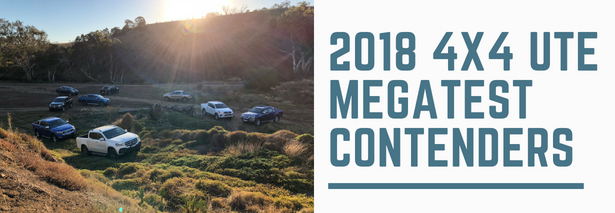Volkswagen’s long-serving Amarok has a new – and potent – lease on life thanks to V6 diesel power.
| Volkswagen Amarok V6 Sportline | $55,990 |
|---|---|
| Volkswagen Amarok V6 Highline | $60,490 |
| Volkswagen Amarok V6 Ultimate | $68,490 |
The Amarok is the oldest ute here (2010), although it only gained its three-litre V6 diesel in late 2016. For its part, the V6 engine actually dates back to 2004 and is a VW family (Audi) design used in various Porsche, Audi and VW models.
For use in the Amarok, it’s been detuned and, at the same time, strengthened in the bottom end to help accommodate its new ‘working’ or commercial vehicle role.
The V6 is only available with an automatic transmission and single-range full-time 4WD at this stage.
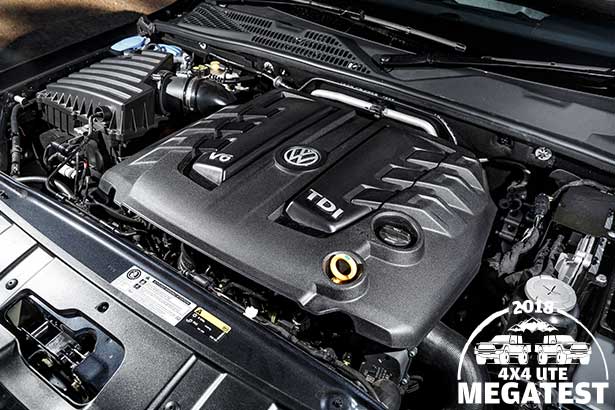 |
Powertrain and performance
Detuned is, however, a relative word here, as the Amarok’s V6 still cranks out at least 165kW (221hp), and as much as 180kW (241hp), if you wish. (Compare that to the next best power figure: the 147kW of the Ranger, BT-50 and Colorado.)
Throw in the closer ratios and quick shifting of the Amarok’s eight-speed automatic, combined with relatively short final drive gearing, and it’s ‘see you later’ in any sort of side-by-side performance contest.
In this company, it’s Amarok first, daylight second.
The 180kW comes via an overboost function that operates at 70 per cent or more throttle in third and fourth gears, the crucial on-road performance and highway overtaking gears. Not that you’d know any of this is happening, as the transition from 165kW to 180kW is totally seamless.
Equally impressive is the V6’s bottom-end torque with its class-whipping 550Nm on tap from just 1,500rpm. That’s more off idle than even the bigger-capacity (3.2-litre) engines in Ranger and BT-50. Combine this low-rpm grunt with a willingness to rev and the V6 offers a potent wide-rpm flexibility that no other engine here can match.
All the while, the V6’s refinement and noise control is the best of any engine here and, along with the eight-speed auto – the slickest gearbox here – it gives the Amarok a unique luxury car feel in this company.
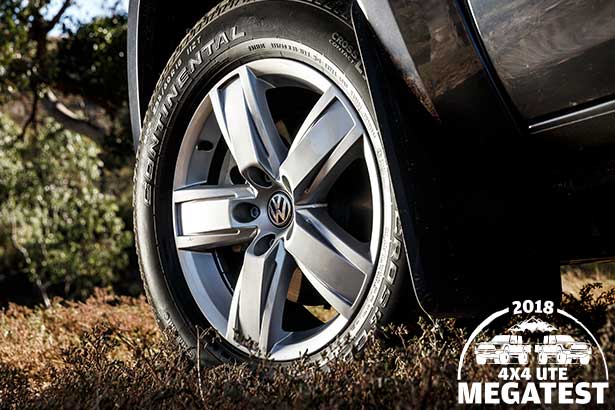 |
On-road ride and handling
Full-time 4×4 is the Amarok’s on-road trump card and something that sets it apart from the other utes here, Triton excepted.
In any conditions aside from dead-dry sealed roads, full-time 4×4 offers grip, safety and driveability advantages. To all this, the Amarok adds quality suspension that generally feels plush in the company, communicative steering and the ‘feel’ of a much smaller ute to provide a driving confidence like no other.
As we have noted before, compared to other utes, the Amarok feels like a rally car.
 |
Load carrying
Class-leading torque is the best way to cope with heavy loads and so the Amarok’s engine dispensed with the 900kg payload easier than any engine here. In fact, it hardly felt it. There was good performance from the chassis too when loaded to the maximum, although it wasn’t as absolutely rock steady as the Ranger.
No doubt the 550Nm would also help when towing the Amarok’s 3,500kg tow limit, which matches the best here, while its 6,000kg GCM matches the Ranger, BT-50 and Colorado. The Sportline, being the lightest of the three Amarok V6s, also has a solid 1,000kg payload figure.
The Amarok’s tray is the only one here to fit a full-size pallet between the wheel arches, a very nice practical touch if you wish to have the looks and aero efficiency of a factory tub combined with some of the load-carrying practicality of an aftermarket tray. You have to wonder why the other ute manufacturers didn’t think of this.
All four of the Amarok’s tie-down hooks in the tub are also mounted low down, where common sense tells you they should be, and there’s also a work light above the tub and a 12-volt outlet – both practical features.
 |
Off road
Without a two-speed high- and low-range transfer case, you might think the Amarok’s star would fade off road, but that’s not the case. In fact, nowhere near it, as the Amarok offers top-shelf off-road ability (matched only by HiLux and Ranger) with an ease of use that puts it well out on its own.
Its number-one party trick is that it can go from whizzing down a freeway at whatever speed you dare to climbing a gnarly off-road hill without having to touch a button or lever. It’s that simple and clever as it always is in 4×4; the centre diff locks automatically and it gets by without low range thanks to a relatively low first gear in the eight-speed automatic and the special calibration of the torque convertor.
The Amarok’s strong off-road performance also comes off the back of its relatively long travel suspension, and, if you do get into difficulty, there’s rear diff lock that keeps the traction control on the front wheels active. Another box ticked. Good vision from the driver’s seat and a ‘clean’ underside are other off-road positives.
The only chink in the Amarok’s off-road armoury is the engine air intake being located in the engine bay, which makes it the first candidate for a snorkel (or a tarp) amongst the best off-road utes if you intend to use if for deeper water fording.
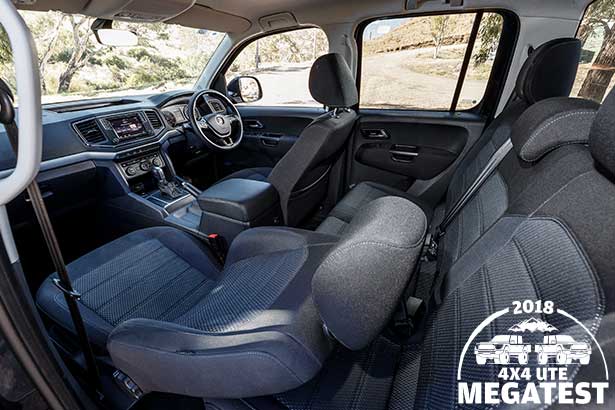 |
Cabin and safety
The Amarok’s cabin is notably spacious (it’s the widest here), very well finished, and offers tilt-and-reach steering wheel adjustment for the driver. The width across the back seat is particularly good with three adults on board, although the combined front-to-rear legroom is not as good as Ranger and BT-50. There are no airbags for rear-seat passengers, however, although it still has a five-star ANCAP safety rating. No sat-nav, either, at this spec level.
Practicalities
A lack of VW dealers in country areas isn’t ideal and some independent workshops would prefer to service something that they are more familiar with. The long service intervals (12 months or 15,000km) do, however, offset this to some extent.
Despite the V6 Amarok getting bigger front brakes than the four-cylinder models, you can still fit 17s to replace the factory 18s (or 19s on up-spec V6s) to open up your tyre choice.
What you get
The Sportline (as tested here) is the cheapest of the Amarok V6 models and looks more like a commercial-grade rather than a recreational ute. Standard equipment includes front and front-side airbags (but no airbags in the rear of the cab), tilt-and-reach steering wheel adjustment and four-wheel disc brakes – equipment that’s also standard with four-cylinder Amarok models. The Sportline V6 also has dual-zone climate, front and rear parking sensors, a rear-view camera, Apple CarPlay, 18-inch alloys and a 12V outlet and lighting for the tray. Unlike the more expensive Highline V6, the Sportline doesn’t have sat-nav, sidesteps, chrome sports bar, tyre-pressure monitoring, bi-xexon headlights and LED daytime running lights.
PROS
- Class of its own in: performance, handling, refinement, cabin space
- Leader in power and torque
- Excellent off-road ability
- Top load-hauling and towing ability
- Tray fits full-size pallet between wheel arches
CONS
- No airbags in the rear of the cabin
VOLKSWAGEN AMAROK V6 PRICE & SPECIFICATIONS
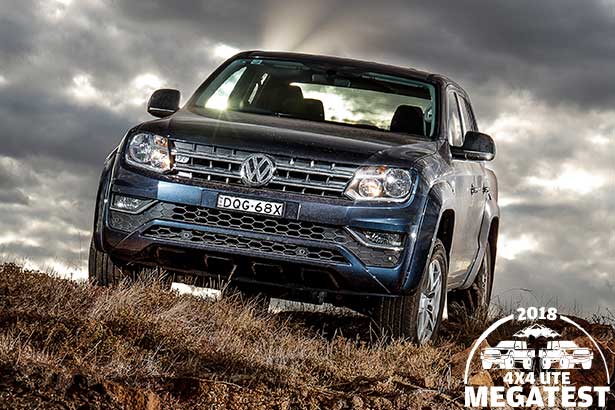 |
| PRICING* | |
|---|---|
| Volkswagen Amarok V6 Sportline | $55,990 |
| Volkswagen Amarok V6 Highline | $60,490 |
| Volkswagen Amarok V6 Ultimate | $68,490 |
| SPECIFICATIONS | |
| Engine | 3.0-litre V6 turbo Diesel |
| Max power | 165kW+ (221hp+) @ 2,500-4,500rpm** |
| Max torque | 550Nm @ 1,500-2,500rpm |
| Gearbox | Eight-speed automatic |
| 4X4 System | Single-range full-time |
| Crawl ratio | 17.4:1 |
| Construction | Separate-chassis |
| Front suspension | Independent/coil springs |
| Rear suspension | Live axle/leaf springs |
| Kerb weight | 2,078kg |
| GVM | 3,080kg |
| Payload | 1,002kg |
| Towing capacity | 3,500kg |
| Towball download (max) | 350kg |
| GCM | 6,000kg |
| Overall length | 5,254mm |
| Width | 1,954mm |
| Height | 1,878mm |
| Wheelbase | 3,095mm |
| Turning circle | 12.95m |
| Fuel tank capacity | 80 litres |
| ADR fuel claim | 7.8 litres/100km |
| Test fuel use | 11.2 litres/100km |
| Touring range | 664km*** |
| ACCELERATION & BRAKING | |
| 0 – 100km/h | 7.9s |
| 80 – 120km/h | 5.3s |
| 100km/h – 0km/h | 48.4m |
*Prices do not include on-road costs or drive-away discounting.
**180kW on over-boost (see text).
***Based on test fuel use, claimed fuel capacity and a 50km ‘safety’ margin.

